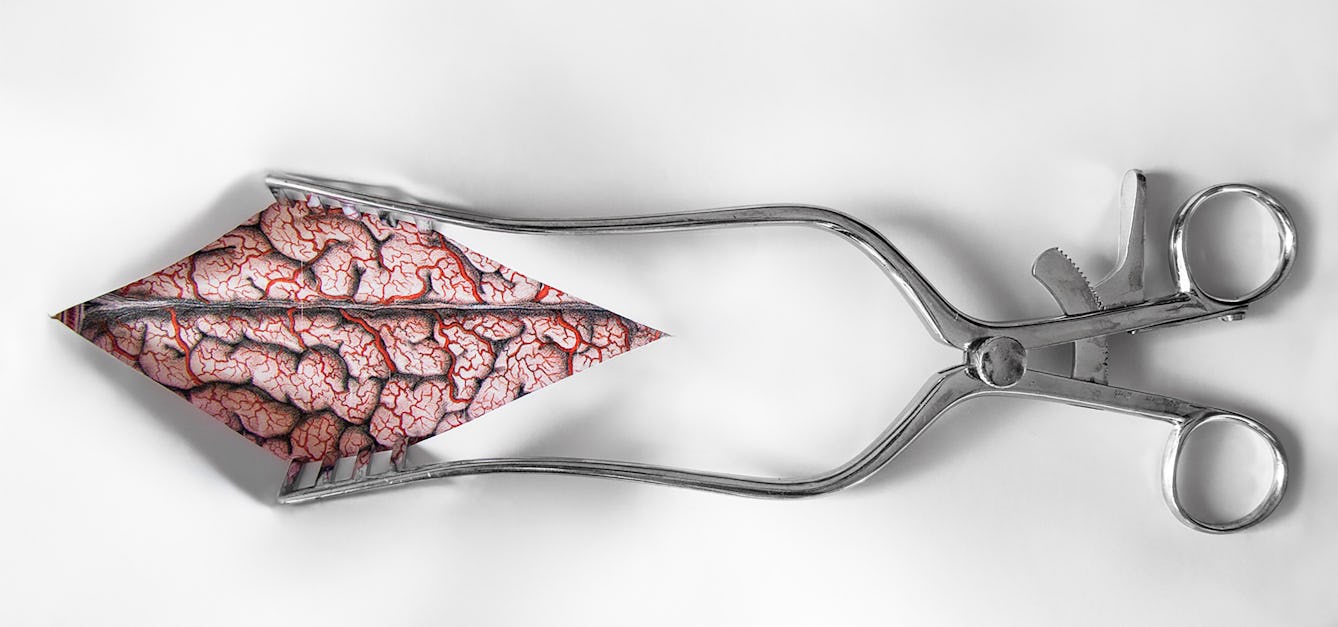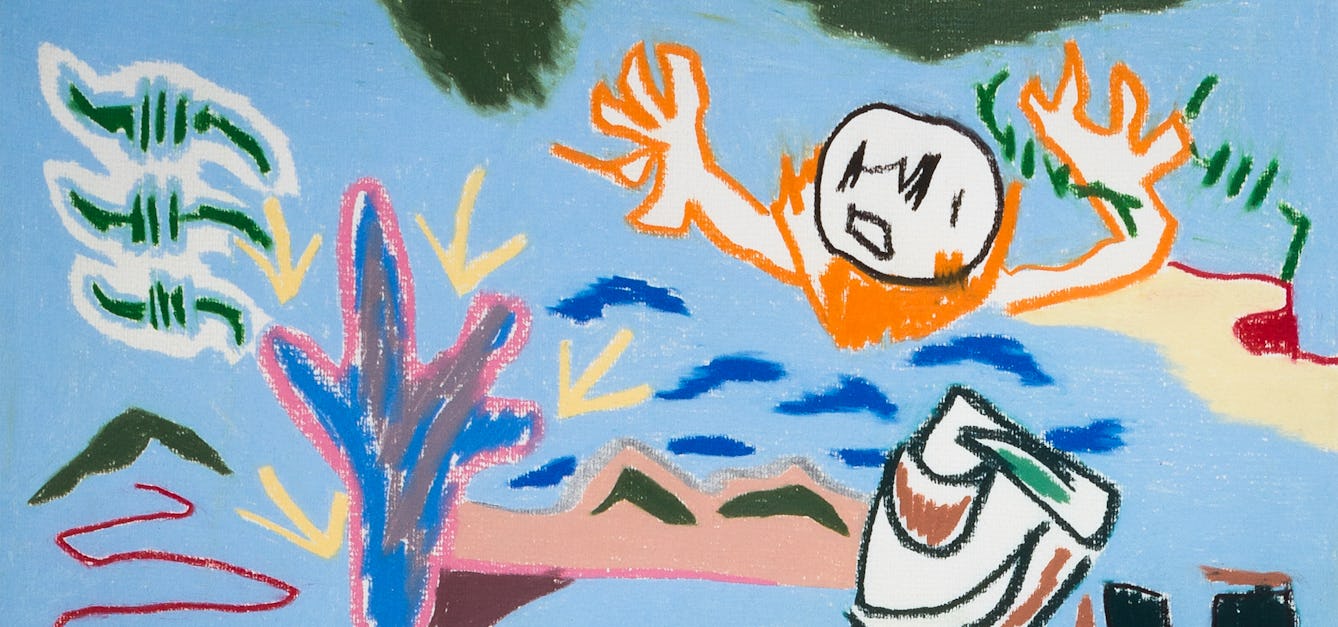Stories

- Article
The mystery of the malignant brain
In 1884 a neurologist successfully used a patient’s symptoms, plus a new kind of map, to locate a brain tumour. Discover how his best-laid plans for treatment worked out.

- Article
How hospital care fails disabled bodies
Hospitals aim to make sick people well. But if the sick person is also disabled, the unbending nature of monolithic hospital systems can easily worsen the situation. Here Jamie Hale writes from painful personal experience.

- Article
The indelible harm caused by conversion therapy
With first-hand evidence from two powerful testimonies, neurologist Jules Montague explores the destructive history of conversion therapy, a punitive treatment designed to ‘cure’ people of homosexuality.

- Article
Pain and the power of touch
As a new physiotherapist, Fiona Murphy quickly learned that her patients’ pain was unpredictable and very personal. But using the right words became the key to helping them.
Catalogue
- Books
Spasm / Lauren Slater.
Slater, Lauren.Date: 2000- Books
Spasm in chronic nerve disease / [Seymour J. Sharkey].
Sharkey, Seymour J.Date: 1886
- Books
- Online
Spasm in chronic nerve disease : being the Gulstonian lectures delivered at the Royal College of Physicians of London, March 1886.
Sharkey, Seymour J.Date: 1886- Archives and manuscripts
- Online
"Migraine Spasm"
Date: 28 February 1983Reference: SA/MAR/260Part of: Migraine Art Competition Collection- Archives and manuscripts
Vascular Spasm
Date: 1950sReference: PP/GWP/C/6/70Part of: Pickering, Sir George White



![Succisia pratensis Greene Asteraceae. Devil’s Bit Scabious, Blue Buttons. Distribution: Europe, W Asia, Africa. Culpeper (1650), under ‘Herbs’ he writes: ‘Succisa, Morsus diobolo, Devil’s Bit. Inwardly taken it easeth the fits of the mother [probably uterine spasm or pain], and breaks wind, taketh away the swellings in the mouth, and slimy phlegm that sticks to the jaws, neither is there a more present remedy in the world, for those cold swellings of the neck, which the vulgar call the Almonds [lymph nodes] of the neck than this herb bruised and applied to them. Folk lore attribute it as a cure-all which was so successful that the Devil bit off the bottom of the roots when he saw it growing down into Hades. However, the roots show no sign of such damage to support the myth. Photographed in the Medicinal Garden of the Royal College of Physicians, London.](https://iiif.wellcomecollection.org/image/B0009208/full/282%2C/0/default.jpg)

![Papaver somniferum L. Papaveraceae Opium Poppy Distribution: Asia minor, but has been dated to 5000BC in Spanish caves. Now grows almost everywhere. The oldest medicine in continuous use, described in the Ebers' papyrus (1550 BC), called Meconium, Laudanum, Paregoric and syrup of poppies. Culpeper (1650) on Meconium '...the juyce of English Poppies boyled till it be thick' and 'I am of the opinion that Opium is nothing else but the juyce of poppies growing in hotter countries, for such Opium as Authors talk of comes from Utopia.[he means an imaginary land, I suspect]’]. He cautions 'Syrups of Poppies provoke sleep, but in that I desire they may be used with a great deal of caution and wariness...' and warns in particular about giving syrup of poppies to children to get them to sleep. The alkaloids in the sap include: Morphine 12% - affects ?-opioid receptors in the brain and causes happiness, sleepiness, pain relief, suppresses cough and causes constipation. Codeine 3% – mild opiate actions – converted to morphine in the body. Papaverine, relaxes smooth muscle spasm in arteries of heart and brain, and also for intestinal spasm, migraine and erectile dysfunction. Not analgesic. Thebaine mildly analgesic, stimulatory, is made into oxycodone and oxymorphone which are analgesics, and naloxone for treatment of opiate overdose – ?-opioid receptor competitive antagonist – it displaces morphine from ?-opioid receptors, and constipation caused by opiates. Protopine – analgesic, antihistamine so relieves pain of inflammation. Noscapine – anti-tussive (anti-cough). In 2006 the world production of opium was 6,610 metric tons, in 1906 it was over 30,000 tons when 25% of Chinese males were regular users. The Opium wars of the end of the 19th century were caused by Britain selling huge quantities of Opium to China to restore the balance of payments deficit. Laudanum: 10mg of morphine (as opium) per ml. Paregoric: camphorated opium tincture. 0.4mg morphine per ml. Gee’s Linctus: up to 60 mg in a bottle. J Collis Browne’s chlorodyne: cannabis, morphine, alcohol etc. Kaolin and Morph. - up to 60 mg in a bottle. Dover’s Powders – contained Ipecacuana and morphine. Heroin is made from morphine, but converted back into morphine in the body (Oakeley, 2012). One gram of poppy seeds contains 0.250mgm of morphine, and while one poppy seed bagel will make a urine test positive for morphine for a week, one would need 30-40 bagels to have any discernible effect. Photographed in the Medicinal Garden of the Royal College of Physicians, London.](https://iiif.wellcomecollection.org/image/B0009101/full/282%2C/0/default.jpg)
![Papaver somniferum L. Papaveraceae Opium Poppy Distribution: Asia minor, but has been dated to 5000BC in Spanish caves. Now grows almost everywhere. The oldest medicine in continuous use, described in the Ebers' papyrus (1550 BC), called Meconium, Laudanum, Paregoric and syrup of poppies. Culpeper (1650) on Meconium '...the juyce of English Poppies boyled till it be thick' and 'I am of the opinion that Opium is nothing else but the juyce of poppies growing in hotter countries, for such Opium as Authors talk of comes from Utopia [he means an imaginary land, I suspect]’. He cautions 'Syrups of Poppies provoke sleep, but in that I desire they may be used with a great deal of caution and wariness...' and warns in particular about giving syrup of poppies to children to get them to sleep. The alkaloids in the sap include: Morphine 12% - affects ?-opioid receptors in the brain and causes happiness, sleepiness, pain relief, suppresses cough and causes constipation. Codeine 3% – mild opiate actions – converted to morphine in the body. Papaverine, relaxes smooth muscle spasm in arteries of heart and brain, and also for intestinal spasm, migraine and erectile dysfunction. Not analgesic. Thebaine mildly analgesic, stimulatory, is made into oxycodone and oxymorphone which are analgesics, and naloxone for treatment of opiate overdose – ?-opioid receptor competitive antagonist – it displaces morphine from ?-opioid receptors, and reverses the constipation caused by opiates. Protopine – analgesic, antihistamine so relieves pain of inflammation. Noscapine – anti-tussive (anti-cough). In 2006 the world production of opium was 6,610 metric tons, in 1906 it was over 30,000 tons when 25% of Chinese males were regular users. The Opium wars of the end of the 19th century were caused by Britain selling huge quantities of Opium to China to restore the balance of payments deficit. Laudanum: 10mg of morphine (as opium) per ml. Paregoric: camphorated opium tincture. 0.4mg morphine per ml. Gee’s Linctus: up to 60 mg in a bottle. J Collis Browne’s chlorodyne: cannabis, morphine, alcohol etc. Kaolin and Morph. - up to 60 mg in a bottle. Dover’s Powders – contained Ipecacuana and morphine. Heroin is made from morphine, but converted back into morphine in the body (Oakeley, 2012). One gram of poppy seeds contains 0.250mgm of morphine, and while one poppy seed bagel will make a urine test positive for morphine for a week, one would need 30-40 bagels to have any discernible effect. Photographed in the Medicinal Garden of the Royal College of Physicians, London.](https://iiif.wellcomecollection.org/image/B0009102/full/282%2C/0/default.jpg)

![Chamaemelum nobile (L.) All. Asteraceae. English, Roman or garden chamomile Distribution: Europe, Mediterranean. Culpeper (1650): “... assuage swellings, inflammations of the bowels, dissolve wind, are profitable given in clysters or drink, to such as are troubled with colic or [renal] stone.” The leaves are pleasantly fragrant, hence its use as a lawn plant, but also in aromatherapy. A ‘tea’ made from the flowers is apparently used to lighten hair colour. Chamomile contains sesquiterpene lactones, and these are known to possess allergenic properties. Hypersensitivity reactions have been reported in this and other members of the Compositae (Asteraceae) and cross sensitivity reactions may occur (Medicines Control Agency, 2002). Analgesic, and used for cramps and spasms (Quincy, 1718). Chamomile tea is used to help sleep, but may cause uterine contractions so avoid in pregnancy (US National Institutes of Health advice). Photographed in the Medicinal Garden of the Royal College of Physicians, London.](https://iiif.wellcomecollection.org/image/B0008965/full/282%2C/0/default.jpg)
